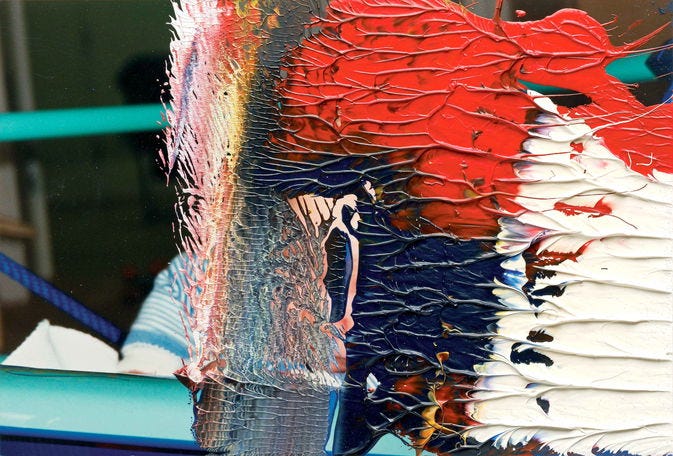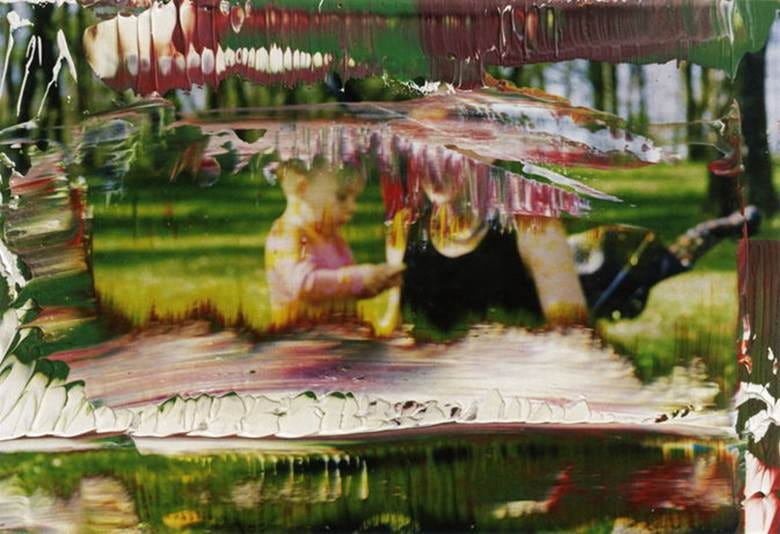The New York Times calls him, ‘the greatest living painter’. The London Times, ‘the world’s most important artist’. So, it’s a little funny to imagine Gerhard Richter standing on a beach taking holiday snaps like anyone else. It’s like Sylvia Plath writing a tweet. But like most of us, throughout his life Richter has made photographs for his family album. There are pictures of his children as babies, of his family in a park and yes, holiday snaps taken on the beach. In our photo-saturated world even Richter has a collection of the sentimental types of pictures we all have. They just also happen to be Gerhard Richters.
If you go to the Neue Nationalgalerie in Berlin you can see a lot of these photographs and you also can’t. And they are really the photographs from his personal photobook and they’re also not. The reason for these oxymorons is that these photographs form the canvas for his lifelong series Overpainted Photographs. They’re both abstract paintings and family photographs; Richter’s quick snaps and the art of the ‘greatest living painter’.
The Overpainted Photographs are Richter’s way of trying to understand what is real and what isn’t. To Richter, ‘photography has almost no reality, it is almost a hundred per cent picture’. When we look at a photograph, we aren’t actually looking at the object in front of us. Photography gives us a slice of reality – or at least it feels like it does, images can be manipulated, staged or abstract, but we are used to thinking of photography as the ‘capturing of moments’. This is especially true for the kind of photographs Richter uses. In this sense the photographs become immaterial. They are the brine in which a moment is preserved rather than an art object in and of themselves. Part of this comes from the fact that unlike paint, photographs have a smooth surface and lack the roughness of painting that proves it exists in the same space as its viewer. It’s why looking at a photograph of a painting feels very different to looking at it in person but seeing a photograph on a wall or a screen feels roughly the same. I’m oversimplifying here, forgive me, but what is broadly true for Richter is that photographs feel less real than paint even when photographs show something easily identifiable and a painting is completely abstract. ‘Painting always has reality, you can touch the paint; it has presence’.
Overpainted Photographs is an experiment where the two states of reality exist at the same time. Both the reality that the photograph purports to have captured and frozen and the physical reality of the paint with its roughness and materiality. The Dusseldorf gallery Sies and Höke describe this as, ‘two levels of reality appear as an interlocking unity, they enter into a close, tension-filled and subtle connection’.
I find it funny to think that Richter now lives in the same neighbourhood as the Institute for Theoretical Physics in Cologne. The Institute is currently running a large research project into how particles can exist in two realities at once that they’re calling Entangled States of Matter. It’s a good title for a show of Richter Overpainted Photographs. These works are incredible because they manage to be two seemingly contradictory things at once, both photographs and abstract painting. Neither has quite managed to erase the other and these unlikely partners dance together surprisingly elegantly.
I went to see them in Berlin’s Neue Nationalgaleire recently. The first one I looked at was of a woman and a child sitting in a park.
It’s unsettling how the woman’s face is erased by the paint. It reminds me of how documents and photographs get redacted with black highlighters. It feels dreamlike. When we dream reality and unreality brush up against one another. Dreams are half-formed of memories and half-formed (science guesses) by the abstract flickering of light as our eyes twitch in the REM stage. As in a dream the image both feels like a memory and also completely abstract.
Abstract art is normally the art of the present. You look at it and respond in the moment. It makes you feel things through the actual experience of looking. Family photographs are the art of the past they are about memory and about preserving each stage of the people we love so that we can look back at them. Here Richter has the past and the present collide into one another, the image in the photograph is nostalgic but the painting drags our minds to the present, the paint even looks as if it is still drying.
Or take this work. This one’s a little different. Here the original photograph is already quite abstract. The sea meeting the horizon is a far more abstract image than a family photograph of a woman and a child. It’s harder to explain why it was taken. In the family picture above the answer is obvious: to remember. Here it’s more complicated. Perhaps to notice. Watching the sea stretch out to infinity and the sky curve down to meet it is a beautiful sight. To take a camera and make a photograph of something is an act of noticing. To notice is to say something matters. It’s the solitary equivalent to taking a walk with a friend and pointing out a particularly pretty flower. This implies that there is something pseudo-sacred about photography - that it is a process that can make things matter. So, what happens when the image is painted over? It’s almost like a scared object is desecrated. Here the blue of the sea and sky are in harmony with one another, and the much brighter paint seems to rudely interrupt.
Richter plays wonderfully with scale here. The sea stretches on forever, but we can see fissures in the paint from where he has smeared it. He makes us look both in macroscopic and microscopic at the same time.
The Overpainted Photographs are fun. They’re worth having a look at – he has a very good archive on his website of most of them1. They’re an interesting experiment into the layers of reality art operates on. It’s also nice to see that even Gerhard Richter takes family snaps.
They’re not the only work where Richter combines photography and painting. Birkenau, is a series of four paintings based on photographs but not by painting directly on top of them. They’re Richter’s response to the Shoah, his attempt to answer if art can reckon with the horrors of what happened at concentration camps. From here on I’ll be writing about the Holocaust so if that’s not content you’d like to read about at this time, stop reading here.
Birkenau are based directly on four photographs taken secretly by prisoners at the death camp of Auschwitz-Birkenau. The museum built on the site of the former camp estimates that 1.1 million people were systematically murdered here.
One of the photographs that was smuggled out of Auschwitz-Birkenau shows a pile of corpses being burnt as Nazi officers look on. They appear completely calm. They’re chatting. It’s normal for them. It’s a horrific image. One that shocks you at how cruel humans can be and how disgustingly efficient and violent the Nazi machine was. Like many images of the Shoah, once you’ve seen it you can’t forget it.
Richter was trying to see if paint could have the same effects on viewers as these photographs. In the aftermath of the Holocaust, when it came time for Germans like Richter to reckon with that had happened and to begin the slow process of understanding it to ensure it wouldn’t happen again, Richter has to answer the question of whether art was capable to address this history. To do this he projected this photograph and three others like it, onto a canvas and traced them. Over these tracings he began to paint until the original photographs’ contents were impossible to be seen. It can still be felt, the violence the terror somehow cling to the image long after its original reference has gone. Unlike in the Overpainted Photographs, the paint and photograph don’t coexist. The painting takes over completely and yet even in this most abstract form, even when there is nothing recognisable in the painting, when it is a canvas of just colour, scratches and blurs still the horror of that photograph remains.
In a sense Birkenau is one of the Overpainted Photographs but overpainted to such a degree that the photograph cannot be seen at all in the work, only felt somewhere deep inside of us. The Overpainted Photographs are about memory. About how we remember and how memory fades. They’re nostalgic. Birkenau is about a different kind of memory. A kind memory that looks at the horrors of the death camps and turns to the future to promise, ‘never again’. Richter has managed to make abstract art not bound to the present but horrified at the past and concerned for the future.
Nostalgia is the longing for the past to be in the present. The Overpainted Photographs achieve a version of this seeming temporal impossibility. Birkenau is the exact opposite kind of memory. In Birkenau Richter sees the past and begins the work of ensuring it never repeats itself.
The camera used to make the photographs Richter used was smuggled into Auschwitz-Birkenau by a Polish resistance group. The photographs were made by the Sonderkommando, Jewish workers forced to burn the bodies from the gas chambers. It was smuggled out by a Polish woman called Helena Datoń. The images were used as evidence for the crimes committed at Auschwitz-Birkenau. I’ve chosen not to show them here but they can be accessed on the World Holocaust Memorial Centre’s Website.
https://www.gerhard-richter.com/en/art/overpainted-photographs






